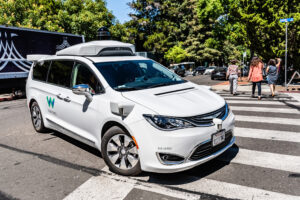
Public disdain possible cause of recent autonomous vehicle attacks, articles say
By onTechnology
Autonomous vehicles are under attack in San Francisco as public disdain for tech companies in the city appears to grow, according to multiple media sources.
Earlier this month, a San Francisco mob smashed the windows on a Waymo vehicle, leading to a fire, after placing fireworks inside, according to an Independent article. No one was inside the vehicle.
“Some believe it was also a symbol of the growing resentment against AI and Big Tech,” the article says.
The real robot apocalypse:
Apocalypse *of* the robots,
not *by* the robots. https://t.co/PWMN5aX9bu— Yann LeCun (@ylecun) February 12, 2024
This past summer, NPR reported on an anonymous activist group, Safe Street Rebel, using traffic cones to disable Cruise and Waymo autonomous vehicles to protest the city being used as a testing ground for the technology.
The group triggers the vehicles’ emergency responses by placing traffic cones on the hoods. The vehicles sit disabled until reset.
“Coning driverless cars fits in line with a long history of protests against the impact of the tech industry on San Francisco,” the NPR story says. “Throughout the years, activists have blockaded Google’s private commuter buses from picking up employees in the city. And when scooter companies flooded the sidewalks with electric scooters, people threw them into San Francisco Bay.”
The recent Waymo attack isn’t the first time protestors have started a fire to make a statement. In 2018, Vice reported about an Instagram page dedicated to images and videos of rideshare scooters being torched, thrown off buildings, and tossed into the ocean.
According to NPR, Safe Street Rebel has recently focused on autonomous vehicles, with the group tracking every traffic incident Cruise and Waymo vehicles are involved in.
Fear or panic of AI taking over jobs could be pointed at the autonomous rideshare vehicles as one of the only physical representations of a machine taking a human job, the Independent article theorizes.
“Eyewitnesses of the latest incident said the attack appeared to begin spontaneously, however, the manner in which people joined in hinted at underlying grievances,” the Independent article says. “Investigators are still trying to determine what prompted the attack, which was the most destructive attack on a driverless car in the U.S. so far, though fears are already spreading that it may be the start of something more.”
Days after the attack on Waymo’s vehicle, the company voluntarily recalled 444 vehicles with the National Highway Traffic Safety Administration (NHTSA) for a software issue, a Waymo release says.
“We chose to do this after consultation with NHTSA and our own internal review of two incidents that occurred in a rare scenario in Phoenix on December 11, 2023, which resulted in no injuries and minor vehicle damage,” the Waymo release said. “Our entire fleet was updated with software to address this rare issue between December 20, 2023 and January 12, 2024. Our ride-hailing service is not and has not been interrupted by this update.”
The Dec. 11 incident involved a towed pickup truck being struck by two different Waymo vehicles in a matter of minutes, the release said. It said the truck was being towed improperly and was angled across a center turn lane and a traffic lane. The Waymo vehicles were riderless.
A Waymo collision with a cyclist in San Francisco last week has brought more attention to the company, according to the Independent article. It says there were more than 130 autonomous vehicle incidents last year, with some resulting in injuries.
The company released a study late last year claiming its autonomous vehicles are safer than human drivers. It said Waymo saw an 85% reduction or 6.8 times lower crash rate involving any injury from minor to severe and fatal crashes or 0.41 incidence per 1 million miles for the Waymo Driver versus 2.78 for the human benchmark.
The California Department of Motor Vehicles (DMV) suspended the deployment and driverless testing of Cruise in October, in part due to safety, but also because the state said Cruise “misrepresented” information related to the vehicles’ safety.
The suspension came days after safety concerns regarding an August collision between a Cruise vehicle and a firetruck in San Francisco and a pedestrian-involved incident in October. Cruise later paused autonomous driving in all its locations.
Earlier this month, Cruise announced the hiring of Steve Kenner as its Chief Safety Officer. Kenner has held top positions at Ford and Kodiak in recent years.
“Safety governance is a critical gating factor as we return to our mission and get Cruise cars back on the road safely,” Mo Elshenawy, Cruise president and chief technology officer, said in the release. “We know that safety is a mindset every engineer and employee throughout Cruise embraces and that greater accountability will be developed through Steve’s expert leadership.”
Tesla and its autonomous features have also been under fire recently, with two Super Bowl ads from The Dawn Project targeting it as dangerous. The group states on its website that it advocates for the safe use of computers.
Late last year, Tesla recalled more than 2 million vehicles upon the conclusion of a two-year investigation into the safety of the vehicles by the NHTSA.
IMAGES
Photo courtesy of Sundry Photography/iStock
